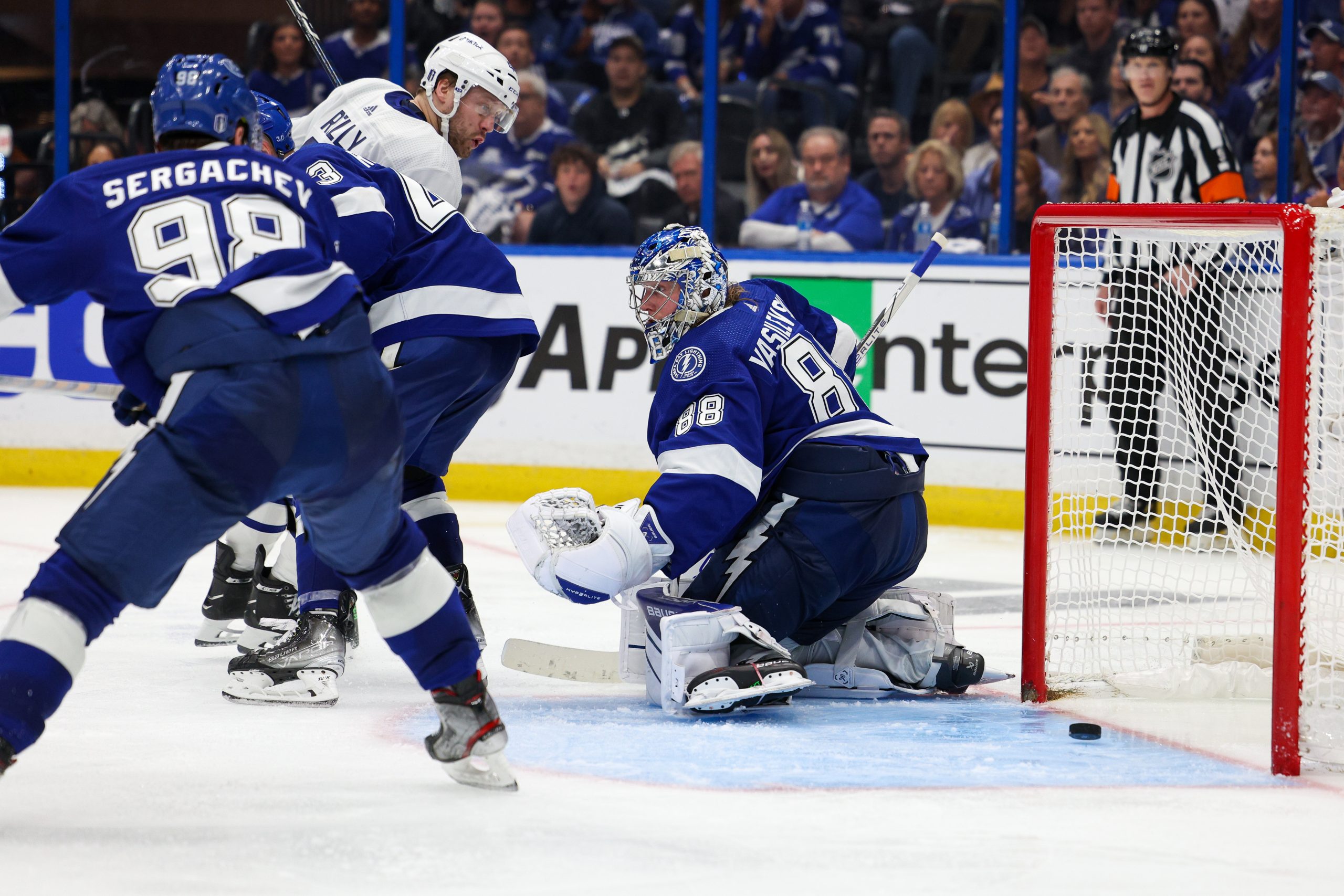The Tampa Bay Lightning fell short to the Toronto Maple Leafs in the very first round of the 2023 Stanley Cup playoffs. They were previously on a streak of three consecutive Stanley Cup Final appearances, with back-to-back wins. But, instead of that streak extending, the Maple Leafs streak of first-round losses came to an end. A big reason for that was the relatively poor performances from the Tampa Bay Lightning’s Andrei Vasilevskiy.
Tampa Bay Lightning Andrei Vasilevskiy Struggles
In prior seasons, Tampa Bay Lightning Andrei Vasilevskiy was arguably the best goaltender in the league. Since becoming a starter in the 2016-17 season, he has been nominated for the Vezina Trophy four times, and finished top-five in voting five times. That included one Vezina Trophy win (2018-19). Since entering the league in 2014-15, he has never recorded under a 0.910 save percentage. In his career, the 19th overall selection in 2012 has a record of 263-123-28, with 32 shut-outs, a 2.52 goals against average and a 0.919 save percentage.
What Issues Vasilevskiy Dealt With This Season
Tampa Bay Lightning Andrei Vasilevskiy, despite his greatness, has had one fatal flaw pop up in his game. The first major notes on this said flaw reared its head in this tweet back in the 2022 playoffs:
Vasilevskiy now at 18 goals against high-blocker.
More than that, has an .809 high blocker save % which ranks 16th out of 17 qualified goalies.
More than that, .588 on seam pass shots where he moves from glove side to blocker side (16th). https://t.co/82NSw09xpn— Mike Kelly (@MikeKellyNHL) June 5, 2022
In this tweet from Mike Kelly, he breaks down how Vasilevskiy struggled with his blocker side entering the Eastern Conference Finals match up against the New York Rangers. This tweet followed a Rangers game one win, in which that weakness made its presence felt. Well, history does repeat itself. Between this writer, Cam Charron of The Athletic, and some mention and video analysis from goalie coach Rob Gherson, it’s clear that history did repeat itself. Much to the ire of Lightning fans.
Breaking Down Vasilevskiy’s Regular Season
Before we get to the postseason, let’s take a look at his regular season. Going back and watching each and every goal that Vasilevskiy gave up, what were the results? Vasilevskiy gave up 159 total goals this season, across 60 games this season. Of those goals, 44.65% of them were aimed at the blocker side (71 goals allowed). He also allowed 64 glove side goals, which was 40.25%.
Breaking it down even more, 40 of the 71 blocker side goals went low blocker (56.34%) while 31 went high blocker (43.66%). As for his glove side, 34 of those went high (53.13%) and 30 went low (46.87%). When looking at shots that beat him high, combined, he gave up 65 goals (40.88%), while 92 (counting the 22 that beat him five-hole), beat him low (57.86%). There were two goals scored this season with Vasilevskiy not in position, which made up 1.26% of the goals.
Deeper Dive
The raw numbers don’t really show any clear or concise issue within Vasilevskiy’s game. Yes, he let in more blocker goals than glove goals, but not by any substantial amount. Let’s break it down further by how the goal developed. Was there any traffic in front of Vasilevskiy or did he have a clear lane to track the shot? Was it off the rush? A one-timer? Was there no dangerous puck movement before the goal was scored?
Well, in total, 88 goals were scored with no traffic in front (55.35%). Of those, 54 had no dangerous puck movement seconds before the goal (61.36%). That includes 28 goals off the rush with no traffic (51.85% of those 54 goals). As for the goals scored with traffic, there were 71 goals (44.65%). Of those 71, six were scored with no dangerous puck movement (8.45%). What this shows is, the more chaotic things are in front of Vasilevskiy, the better he plays, within reason. He gave up less goals with traffic in front of him. When there was no traffic, and there was no real threat in terms of puck movement, he seemed to be a bit too relaxed. When there was traffic, and there was no movement, he was locked in and able to make the save.
The Trends For Tampa Bay Lightning Andrei Vasilevskiy
As slightly mentioned above, when there was no traffic and no dangerous puck movement, Vasilevskiy seemed to be maybe caught by surprise with shots, especially those off the rush. When there was traffic, Vasilevskiy was locked in on the puck until it either was moved (12 one-timer goals with traffic) or was tipped (28 tipped goals with traffic).
So, what was his performance like in the postseason? What were the kinds of goals he gave up? Where was he beat, and how?
Vasilevskiy Vs. Leafs Round One
In the playoffs, Vasilevskiy allowed 23 total goals in six games. Of those 23, 11 of them beat Vasilevskiy blocker side. Of those 11, five of them went high, while six went low. Meanwhile, he also allowed eight goals glove side (six high, two low) and four went five hole. Additionally, of those 23 goals, nine came with no traffic in front (six with no dangerous puck movement before the goal) and 14 came with traffic (three with no dangerous puck movement).
To break it down, the Leafs ultimately knew what they needed to do in order to beat Tampa Bay Lightning Andrei Vasilevskiy. If you get traffic in front of him, move the puck. They had the weapons to do so in Auston Matthews, Mitch Marner, and William Nylander, among others, to get off one-timers while getting traffic in front. It also helps when former assistant coach, Derek LaLonde, talks about how he had to change the entire defensive zone structure in Tampa to prevent traffic to the whole world. But it was clear beforehand that the Leafs knew, and it showed.
Tampa Bay Lightning Andrei Vasilevskiy Wrap Up
When they didn’t have traffic in front, they faced Vasilevskiy head on and tested his blocker consistently, and it paid off. If it’s hard to believe that, look at this video breakdown from Rob Gherson on the technical flaws in Vasilevskiy’s blocker side (below). It’s clear as day why Toronto kept attacking him there. It’s also clear as day why they kept attacking him the way they did. Vasilevskiy struggles, pretty clearly, in the aforementioned areas in his game. Toronto took full advantage. They got to see the second round because of it.
A short video on Vasilevskiy's blocker arm as game 1 gets started. You might have to pause to see the analysis. #consciousgoaltending pic.twitter.com/VaZId6UsNh
— Rob Gherson (@goalie_school) April 24, 2023
Main Photo: Nathan Ray Seebeck-USA TODAY Sports






